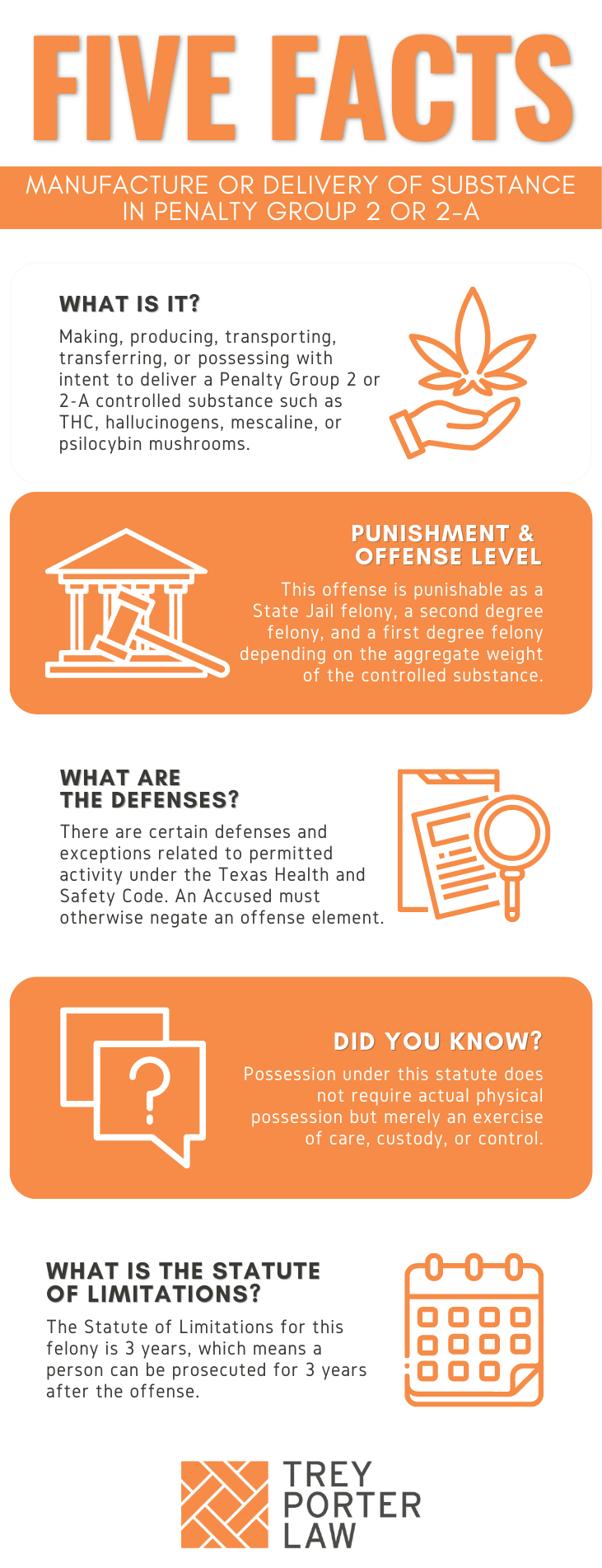WHAT IS MANUFACTURE OR DELIVERY OF SUBSTANCE IN PENALTY GROUP 2 OR 2-A IN TEXAS?
The Texas law against manufacture or delivery of substance in Penalty Group 2 or 2-A prohibits making, producing, transporting, transferring, or otherwise possessing with the intent to deliver a controlled substance listed in Penalty Group 2 or 2-A.
- What is a controlled substance? Texas Health and Safety Code Section 481.002 defines a “controlled substance” as a substance, including a drug, listed in Schedules I through V or Penalty Group 1, 1-A, 1-B, 2, 2-A, 3, or 4. The term includes the aggregate weight of any mixture, solution, or other substance containing a controlled substance, but does not include “hemp” as defined by Texas Agriculture Code Section 121.001, or the tetrahydrocannabinols in hemp.
- What is the difference between Schedules I, II, III, IV, and V and the penalty groups of controlled substances? Controlled substances are divided into five “schedules” based on potential for abuse or addiction, which dictate the rules medical professionals must follow in prescribing medications listed in each schedule. Schedule I, for example, are the most addictive substances, and may generally not be prescribed. Substances in Schedule I are also typically in Penalty Group 1, and are considered illegal under most circumstances.
Controlled substances are divided into “penalty groups” for determining criminal classification and penalties. What controlled substances are in Penalty Group 2 in Texas?
According to Texas Health and Safety Code Section 481.103, Penalty Group 2 consists of:
- any quantity of the following hallucinogenic substances, their salts, isomers, and salts of isomers, unless specifically excepted, if the existence of these salts, isomers, and salts of isomers is possible within the specific chemical designation:
- 5-(2-aminopropyl)benzofuran (5-APB);
- 6-(2-aminopropyl)benzofuran (6-APB);
- 5-(2-aminopropyl)-2,3-dihydrobenzofuran (5-APDB);
- 6-(2-aminopropyl)-2,3-dihydrobenzofuran (6-APDB);
- 5-(2-aminopropyl)indole (5-IT,5-API);
- 6-(2-aminopropyl)indole (6-IT,6-API);
- 1-(benzofuran-5-yl)-N-methylpropan-2-amine (5-MAPB);
- 1-(benzofuran-6-yl)-N-methylpropan-2-amine (6-MAPB);
- Benzothiophenylcyclohexylpiperidine (BTCP);
- 8-bromo-alpha-methyl-benzo[1,2-b:4,5-b′]difuran-4-ethanamine (trade or other name: Bromo-DragonFLY);
- Desoxypipradrol (2-benzhydrylpiperidine);
- 2, 5-dimethoxyamphetamine (some trade or other names: 2, 5-dimethoxy-alpha-methylphenethylamine; 2, 5-DMA);
- Diphenylprolinol (diphenyl(pyrrolidin-2-yl) methanol, D2PM);
- Dronabinol (synthetic) in sesame oil and encapsulated in a soft gelatin capsule in a U.S. Food and Drug Administration approved drug product (some trade or other names for Dronabinol: (a6aR-trans)-6a,7,8,10a-tetrahydro-6,6, 9-trimethyl-3-pentyl-6H-dibenzo [b,d]pyran-1-ol or (-)-delta-9-(trans)-tetrahydrocannabinol);
- Ethylamine Analog of Phencyclidine (some trade or other names: N-ethyl-1-phenylcyclohexylamine, (1-phenylcyclohexyl) ethylamine, N-(1-phenylcyclohexyl) ethylamine, cyclohexamine, PCE);
- 2-ethylamino-2-(3-methoxyphenyl)cyclohexanone (trade or other name: methoxetamine);
- Ibogaine (some trade or other names: 7-Ethyl-6, 6, beta 7, 8, 9, 10, 12, 13-octahydro-2-methoxy-6, 9-methano-5H-pyrido [1′, 2′:1, 2] azepino [5, 4-b] indole; tabernanthe iboga.);
- 5-iodo-2-aminoindane (5-IAI);
- Mescaline;
- 5-methoxy-3, 4-methylenedioxy amphetamine;
- 4-methoxyamphetamine (some trade or other names: 4-methoxy-alpha-methylphenethylamine; paramethoxyamphetamine; PMA);
- 4-methoxymethamphetamine (PMMA);
- 2-(2-methoxyphenyl)-2-(methylamino)cyclohexanone (some trade and other names: 2-MeO-ketamine; methoxyketamine);
- 1-methyl-4-phenyl-4-propionoxypiperidine (MPPP, PPMP);
- 4-methyl-2, 5-dimethoxyamphetamine (some trade and other names: 4-methyl-2, 5-dimethoxy-alpha-methylphenethylamine; “DOM”; “STP”);
- 3,4-methylenedioxy methamphetamine (MDMA, MDM);
- 3,4-methylenedioxy amphetamine;
- 3,4-methylenedioxy N-ethylamphetamine (Also known as N-ethyl MDA);
- 5,6-methylenedioxy-2-aminoindane (MDAI);
- Nabilone (Another name for nabilone: (+)-trans-3-(1,1-dimethylheptyl)-6,6a, 7,8,10,10a-hexahydro-1-hydroxy-6, 6-dimethyl-9H-dibenzo[b,d] pyran-9-one;
- N-benzylpiperazine (some trade or other names: BZP; 1-benzylpiperazine);
- N-ethyl-3-piperidyl benzilate;
- N-hydroxy-3,4-methylenedioxyamphetamine (Also known as N-hydroxy MDA);
- 4-methylaminorex;
- N-methyl-3-piperidyl benzilate;
- Parahexyl (some trade or other names: 3-Hexyl-1-hydroxy-7, 8, 9, 10-tetrahydro-6, 6, 9-trimethyl-6H-dibenzo [b, d] pyran; Synhexyl);
- 1-Phenylcyclohexylamine;
- 1-Piperidinocyclohexanecarbonitrile (PCC);
- Pyrrolidine Analog of Phencyclidine (some trade or other names: 1-(1-phenylcyclohexyl)-pyrrolidine, PCPy, PHP);
- Tetrahydrocannabinols, other than marihuana, and synthetic equivalents of the substances contained in the plant, or in the resinous extractives of Cannabis, or synthetic substances, derivatives, and their isomers with similar chemical structure and pharmacological activity such as:
- delta-1 cis or trans tetrahydrocannabinol, and their optical isomers;
- delta-6 cis or trans tetrahydrocannabinol, and their optical isomers;
- delta-3, 4 cis or trans tetrahydrocannabinol, and its optical isomers; or
- compounds of these structures, regardless of numerical designation of atomic positions, since nomenclature of these substances is not internationally standardized;
- Thiophene Analog of Phencyclidine (some trade or other names: 1-[1-(2-thienyl) cyclohexyl] piperidine; 2-Thienyl Analog of Phencyclidine; TPCP, TCP);
- 1-pyrrolidine (some trade or other name: TCPy);
- 1-(3-trifluoromethylphenyl)piperazine (trade or other name: TFMPP); and
- 3,4,5-trimethoxy amphetamine;
- Phenylacetone (some trade or other names: Phenyl-2-propanone; P2P, Benzymethyl ketone, methyl benzyl ketone);
- unless specifically excepted or unless listed in another Penalty Group, a material, compound, mixture, or preparation that contains any quantity of the following substances having a potential for abuse associated with a depressant or stimulant effect on the central nervous system:
- Aminorex (some trade or other names: aminoxaphen; 2-amino-5-phenyl-2-oxazoline; 4,5-dihydro-5-phenyl-2-oxazolamine);
- Amphetamine, its salts, optical isomers, and salts of optical isomers;
- Cathinone (some trade or other names: 2-amino-1-phenyl-1-propanone, alpha-aminopropiophenone, 2-aminopropiophenone);
- Etaqualone and its salts;
- Etorphine Hydrochloride;
- Fenethylline and its salts;
- Lisdexamfetamine, including its salts, isomers, and salts of isomers;
- Mecloqualone and its salts;
- Methaqualone and its salts;
- Methcathinone (some trade or other names: 2-methylamino-propiophenone; alpha-(methylamino)propriophenone; 2-(methylamino)-1-phenylpropan-1-one; alpha-N-methylaminopropriophenone; monomethylpropion; ephedrone, N-methylcathinone; methylcathinone; AL-464; AL-422; AL-463; and UR 1431);
- N-Ethylamphetamine, its salts, optical isomers, and salts of optical isomers; and
- N,N-dimethylamphetamine (some trade or other names: N,N,alpha-trimethylbenzeneethanamine; N,N,alpha-trimethylphenethylamine), its salts, optical isomers, and salts of optical isomers;
- any compound structurally derived from 2-aminopropanal by substitution at the 1-position with any monocyclic or fused-polycyclic ring system, including:
- compounds further modified by:
- substitution in the ring system to any extent (including alkyl, alkoxy, alkylenedioxy, haloalkyl, or halide substituents), whether or not further substituted in the ring system by other substituents;
- substitution at the 3-position with an alkyl substituent; or
- substitution at the 2-amino nitrogen atom with alkyl, benzyl, dialkyl, or methoxybenzyl groups, or inclusion of the 2-amino nitrogen atom in a cyclic structure; and
- by example, compounds such as:
- 4-Methylmethcathinone (Also known as Mephedrone);
- 3,4-Dimethylmethcathinone (Also known as 3,4-DMMC);
- 3-Fluoromethcathinone (Also known as 3-FMC);
- 4-Fluoromethcathinone (Also known as Flephedrone);
- 3,4-Methylenedioxy-N-methylcathinone (Also known as Methylone);
- 3,4-Methylenedioxypyrovalerone (Also known as MDPV);
- alpha-Pyrrolidinopentiophenone (Also known as alpha-PVP);
- Naphthylpyrovalerone (Also known as Naphyrone);
- alpha-Methylamino-valerophenone (Also known as Pentedrone);
- beta-Keto-N-methylbenzodioxolylpropylamine (Also known as Butylone);
- beta-Keto-N-methylbenzodioxolylpentanamine (Also known as Pentylone);
- beta-Keto-Ethylbenzodioxolylbutanamine (Also known as Eutylone); and
- 3,4-methylenedioxy-N-ethylcathinone (Also known as Ethylone);
- compounds further modified by:
- any compound structurally derived from tryptamine (3-(2-aminoethyl)indole) or a ring-hydroxy tryptamine:
- (A) by modification in any of the following ways:
- (i) by substitution at the amine nitrogen atom of the sidechain to any extent with alkyl or alkenyl groups or by inclusion of the amine nitrogen atom of the side chain (and no other atoms of the side chain) in a cyclic structure;
- (ii) by substitution at the carbon atom adjacent to the nitrogen atom of the side chain (alpha-position) with an alkyl or alkenyl group;
- (iii) by substitution in the 6-membered ring to any extent with alkyl, alkoxy, haloalkyl, thioaklyl, alkylenedioxy, or halide substituents; or
- (iv) by substitution at the 2-position of the tryptamine ring system with an alkyl substituent; and
- (B) including:
- (i) ethers and esters of the controlled substances listed in this subdivision; and
- (ii) by example, compounds such as:
- alpha-ethyltryptamine;
- alpha-methyltryptamine;
- Bufotenine (some trade and other names: 3-(beta-Dimethylaminoethyl)-5-hydroxyindole; 3-(2-dimethylaminoethyl)-5-indolol; N, N-dimethylserotonin; 5-hydroxy-N, N-dimethyltryptamine; mappine);
- Diethyltryptamine (some trade and other names: N, N-Diethyltryptamine, DET);
- Dimethyltryptamine (trade or other name: DMT);
- 5-methoxy-N, N-diisopropyltryptamine (5-MeO-DiPT);
- O-Acetylpsilocin (Trade or other name: 4-Aco-DMT);
- Psilocin; and
- Psilocybin;
- 2,5-Dimethoxyphenethylamine and any compound structurally derived from 2,5-Dimethoxyphenethylamine by substitution at the 4-position of the phenyl ring to any extent (including alkyl, alkoxy, alkylenedioxy, haloalkyl, or halide substituents), including, by example, compounds such as:
- 4-Bromo-2,5-dimethoxyphenethylamine (trade or other name: 2C-B);
- 4-Chloro-2,5-dimethoxyphenethylamine (trade or other name: 2C-C);
- 2,5-Dimethoxy-4-methylphenethylamine (trade or other name: 2C-D);
- 4-Ethyl-2,5-dimethoxyphenethylamine (trade or other name: 2C-E);
- 4-Iodo-2,5-dimethoxyphenethylamine (trade or other name: 2C-I);
- 2,5-Dimethoxy-4-nitrophenethylamine (trade or other name: 2C-N);
- 2,5-Dimethoxy-4-(n)-propylphenethylamine (trade or other name: 2C-P);
- 4-Ethylthio-2,5-dimethoxyphenethylamine (trade or other name: 2C-T-2);
- 4-Isopropylthio-2,5-dimethoxyphenethylamine (trade or other name: 2C-T-4); and
- 2,5-Dimethoxy-4-(n)-propylthiophenethylamine (trade or other name: 2C-T-7); and
- 2,5-Dimethoxyamphetamine and any compound structurally derived from 2,5-Dimethoxyamphetamine by substitution at the 4-position of the phenyl ring to any extent (including alkyl, alkoxy, alkylenedioxy, haloalkyl, or halide substituents), including, by example, compounds such as:
- 4-Ethylthio-2,5-dimethoxyamphetamine (trade or other name: Aleph-2);
- 4-Isopropylthio-2,5-dimethoxyamphetamine (trade or other name: Aleph-4);
- 4-Bromo-2,5-dimethoxyamphetamine (trade or other name: DOB);
- 4-Chloro-2,5-dimethoxyamphetamine (trade or other name: DOC);
- 2,5-Dimethoxy-4-ethylamphetamine (trade or other name: DOET);
- 4-Iodo-2,5-dimethoxyamphetamine (trade or other name: DOI);
- 2,5-Dimethoxy-4-methylamphetamine (trade or other name: DOM);
- 2,5-Dimethoxy-4-nitroamphetamine (trade or other name: DON);
- 4-Isopropyl-2,5-dimethoxyamphetamine (trade or other name: DOIP); and
- 2,5-Dimethoxy-4-(n)-propylamphetamine (trade or other name: DOPR).
- What controlled substances are in Penalty Group 2-A in Texas? Texas Health and Safety Code Section 481.1031 explains Penalty Group 2-A consists of any material, compound, mixture, or preparation that contains any quantity of a natural or synthetic chemical substance, including its salts, isomers, and salts of isomers, listed by name in this subsection or contained within one of the structural classes defined in this subsection:
-
- WIN-55,212-2;
- Cyclohexylphenol: any compound structurally derived from 2-(3-hydroxycyclohexyl)phenol by substitution at the 5-position of the phenolic ring, (N-methylpiperidin-2-yl)alkyl, (4-tetrahydropyran)alkyl, or 2-(4-morpholinyl)alkyl, whether or not substituted in the cyclohexyl ring to any extent, including:
- JWH-337;
- JWH-344;
- CP-55,940;
- CP-47,497; and
- analogues of CP-47,497;
Penalty Group 2-A also includes:
- cannabinol derivatives, except where contained in marihuana, including tetrahydro derivatives of cannabinol and 3-alkyl homologues of cannabinol or of its tetrahydro derivatives, such as:
- Nabilone;
- HU-210; and
- HU-211;
- (4) Tetramethylcyclopropyl thiazole: any compound structurally derived from 2,2,3,3-tetramethyl-N-(thiazol-2-ylidene) cyclopropanecarboxamide by substitution at the nitrogen atom of the thiazole ring, whether or not further substituted in the thiazole ring to any extent, whether or not substituted in the tetramethylcyclopropyl ring to any extent, including:
- A-836,339;
- any compound containing a core component substituted at the 1-position to any extent, and substituted at the 3-position with a link component attached to a group A component, whether or not the core component or group A component are further substituted to any extent, including:
- Naphthoylindane;
- Naphthoylindazole (THJ-018);
- Naphthyl methyl indene (JWH-171);
- Naphthoylindole (JWH-018);
- Quinolinoyl pyrazole carboxylate (Quinolinyl fluoropentyl fluorophenyl pyrazole carboxylate);
- Naphthoyl pyrazolopyridine; and
- Naphthoylpyrrole (JWH-030);
- any compound containing a core component substituted at the 1-position to any extent, and substituted at the 2-position with a link component attached to a group A component, whether or not the core component or group A component are further substituted to any extent, including:
- Naphthoylbenzimidazole (JWH-018 Benzimidazole); and
- Naphthoylimidazole;
- (7) any compound containing a core component substituted at the 3-position to any extent, and substituted at the 2-position with a link component attached to a group A component, whether or not the core component or group A component are further substituted to any extent, including:
- Naphthoyl benzothiazole; and
- any compound containing a core component substituted at the 9-position to any extent, and substituted at the 3-position with a link component attached to a group A component, whether or not the core component or group A component are further substituted to any extent, including Naphthoylcarbazole (EG-018).
WHAT IS THE MANUFACTURE OR DELIVERY OF SUBSTANCE IN PENALTY GROUP 2 OR 2-A LAW IN TEXAS?
Tex. Health & Safety Code § 481.113. OFFENSE: MANUFACTURE OR DELIVERY OF SUBSTANCE IN PENALTY GROUP 2 OR 2-A.
(a) Except as authorized by this chapter, a person commits an offense if the person knowingly manufactures, delivers, or possesses with intent to deliver a controlled substance listed in Penalty Group 2 or 2-A.
(b) An offense under Subsection (a) is a state jail felony if the amount of the controlled substance to which the offense applies is, by aggregate weight, including adulterants or dilutants, less than one gram.
(c) An offense under Subsection (a) is a felony of the second degree if the amount of the controlled substance to which the offense applies is, by aggregate weight, including adulterants or dilutants, one gram or more but less than four grams.
(d) An offense under Subsection (a) is a felony of the first degree if the amount of the controlled substance to which the offense applies is, by aggregate weight, including adulterants or dilutants, four grams or more but less than 400 grams.
(e) An offense under Subsection (a) is punishable by imprisonment in the Texas Department of Criminal Justice for life or for a term of not more than 99 years or less than 10 years, and a fine not to exceed $100,000, if the amount of the controlled substance to which the offense applies is, by aggregate weight, including adulterants or dilutants, 400 grams or more.
WHAT IS THE PENALTY CLASS FOR MANUFACTURE OR DELIVERY OF SUBSTANCE IN PENALTY GROUP 2 OR 2-A IN TEXAS?
The penalty classification for manufacturing or delivering a controlled substance in Penalty Group 2 or 2-A depends on the aggregate weight of the controlled substance manufactured, delivered, or in the person’s possession.
- State jail felony, punishable by 180 days to two years in a state jail facility, if:
- the aggregate weight was less than one gram;
- Second degree felony, punishable by two to 20 years in prison, if:
- the aggregate weight was one gram or more but less than four grams;
- First degree felony, punishable by five to 99 years or life in prison, if:
- the aggregate weight is four grams or more but less than 400 grams;
- First degree felony, punishable by ten to 99 years or life in prison, if:
- the aggregate weight is 400 grams or more.
WHAT IS THE PUNISHMENT RANGE FOR MANUFACTURE OR DELIVERY OF SUBSTANCE IN PENALTY GROUP 2 OR 2-A IN TEXAS?
The punishment range for manufacturing or delivering a controlled substance in Penalty Group 2 or 2-A corresponds to the penalty classification, which depends on the aggregate weight of the controlled substance.
- 400 grams or more (first degree felony):
- ten to 99 years or life in prison, maximum $100,000 fine;
- Four grams or more but less than 400 grams (first degree felony):
- five to 99 years or life in prison, maximum $10,000 fine;
- One gram or more but less than four grams (second degree felony):
- two to 20 years in prison, maximum $10,000 fine;
- Less than one gram (state jail felony):
- 180 days to two years in a state jail facility, maximum $10,000 fine.
Texas Health and Safety Code Section 481.134 increases the minimum prison sentence by five years and doubles the fine for manufacture or delivery of a controlled substance in Penalty Group 2 or 2-A categorized as a felony, other than a state jail felony, if the offense was committed in a “drug-free zone.” The offense may be increased to the next highest category if committed within an institution of higher learning, within 300 feet of a public swimming pool or arcade, or within 1,000 feet of a residential treatment center.
- What is a drug-free zone in Texas? Texas Health and Safety Code Section 481.134 describes a drug-free zone as:
-
- in, on, or within 1,000 feet of premises of a school (including a day-care center), of premises owned, rented, or leased by an institution of higher learning, the premises of a public or private youth center, or a playground;
- on a school bus; or
- in, on, or within 1,000 feet of premises owned, rented, or leased by a general residential operation operating as a residential treatment center.
WHAT ARE THE PENALTIES FOR MANUFACTURE OR DELIVERY OF SUBSTANCE IN PENALTY GROUP 2 OR 2-A IN TEXAS?
A person charged with manufacturing or delivering less than a gram of a substance in Penalty Group 2 or 2-A is eligible for probation after a conviction, or deferred adjudication without a conviction, for a period between two to five years, with the possibility of extending supervision for up to ten years.
A person charged with first-degree or second-degree felony manufacturing or delivering a controlled substance in Penalty Group 2 or 2-A may be eligible for probation after a conviction, or deferred adjudication without a conviction, for a period not to exceed ten years. A person may only receive probation from a jury if the person has no prior felony convictions, and the jury assessed a prison sentence of ten years or less.
WHAT ARE THE DEFENSES TO MANUFACTURE OR DELIVERY OF SUBSTANCE IN PENALTY GROUP 2 OR 2-A IN TEXAS?
Texas Health and Safety Code Section 481.111 contains certain exemptions in situations recognized as legal to possess or manufacture controlled substances.
Texas Health and Safety Code Section 481.123 provides a defense to a person charged with manufacturing, delivering, or possessing a controlled substance if the substance was approved as a new drug by the FDA, or was exempt by the FDA for investigational use.
A person accused of manufacturing or delivering a substance in Penalty Group 2 or 2-A may further attempt to negate at least one of the elements the State must prove at trial.
- Is medical marijuana legal in Texas? Yes. Texas Health and Safety Code Chapter 487, known as the Texas Compassionate-Use Act, provides the licensing requirements to obtain medical marijuana.Texas Health and Safety Code Section 481.111 also contains an exemption for a person accused of manufacturing, delivering, or possessing with intent to deliver tetrahydrocannabinols or their derivatives if the person is participating in or manufacturing the tetrahydrocannabinols for use in a federally approved therapeutic research program.
- What shows proof of intent to deal drugs in Texas? To convict a person of the higher offense of possession with intent to deliver a controlled substance, the State must show the accused possessed drugs for a purpose other than personal use. This may be shown by circumstantial evidence, the high volume of drugs, or any admissible statements the accused made during the investigation.For example, in Vega v. State, the defendant was sitting in the driver’s seat of a car with his wife when police approached. They saw marijuana in plain view, searched the car, and found a backpack on the floor when his feet were. Inside the backpack, police found ten baggies of methamphetamine. The backpack also had the defendant’s wallet and other possessions. He was convicted of possession with intent to deliver a controlled substance in PG1 (methamphetamine), and the appellate court affirmed.
- Is a lab test required in drug cases in Texas? Generally, yes. A person should not be convicted of possessing, manufacturing, or delivering a controlled substance in a specifically alleged penalty group without a lab report verifying the drug was the controlled substance alleged.In Ex parte Saucedo, the defendant was indicted for possession of methamphetamine, a controlled substance in Penalty Group 1. He pled before the lab results were sent to the prosecution, and was sentenced. The lab report revealed the defendant was actually in possession of methylethcathinone, a substance in Penalty Group 2. The Court of Criminal Appeals granted habeas relief, and cautioned all trial attorneys and defendants against pleading without all the evidence.
- What is drug possession in Texas? Texas Health and Safety Code Section 481.002 defines “possession” as actual care, custody, control, or management. Possession does not require proof a person is physically holding the controlled substance.In Rodriguez v. State, No. 04-21-00503-CR, the defendant’s girlfriend let her friend drive the defendant to the store. Police stopped the car while the defendant was in the passenger seat, and found 0.18 grams of methamphetamine in a chewing tobacco tin in the glove box. The officer noticed tobacco around the defendant’s mouth, so he was charged with and convicted of possession of less than a gram of a controlled substance in Penalty Group 1.The appellate court affirmed. The drugs were conveniently accessible to the defendant on his side of the car, they were in a tobacco tin, and the defendant chewed tobacco.
- What is a search incident to arrest in Texas? The Fourth Amendment to the U.S. Constitution permits police officers to conduct warrantless searches incident to lawful arrests. The justification for permitting such a warrantless search is: (1) the need for officers to seize weapons or other things which might be used to assault an officer or effect an escape; and (2) the need to prevent the loss or destruction of evidence. See State v. Granville, 423 S.W.3d 399, 410 (Tex. Crim. App. 2014).In State v. Sanchez, an officer approached the defendant’s jeep, which was parked in a grassy area next to a bar with the driver’s door open, the engine turned off, and the defendant was asleep in the driver’s seat. The officer woke the defendant up to check on him, and learned he had traffic warrants. Incident to arrest, the officer searched the defendant’s pockets, and he had cocaine. He was then arrested for possession of a controlled substance in PG 1, his car was searched incident to that arrest, and more cocaine was found. The appellate court upheld the car search as a valid search incident to his arrest for possession.In Botello v. State, police responded to an assault-in-progress. The officer spoke to the victim outside the home, who said the defendant was her estranged husband, had assaulted her, and was still inside. The defendant refused to come out, but the victim consented to a search of the home, so police forcefully went inside. Officers immediately arrested the defendant for assault, searched his pockets, and found over 24 grams of heroin. He was convicted of possession of a controlled substance in PG 1, and the appellate court affirmed.
WHAT IS THE STATUTE OF LIMITATIONS FOR MANUFACTURE OR DELIVERY OF SUBSTANCE IN PENALTY GROUP 2 OR 2-A IN TEXAS?
The limitation period for manufacturing or delivering a substance in penalty group 2 or 2-A is three years.
MANUFACTURE OR DELIVERY OF SUBSTANCE IN PENALTY GROUP 2 OR 2-A IN TEXAS
Texas punishes manufacturing, growing, transporting, delivering, or otherwise possessing with the intent to deliver a controlled substance in Penalty Group 2 or 2-A in any amount as a felony.
TEXAS MANUFACTURE OR DELIVERY OF SUBSTANCE IN PENALTY GROUP 2 OR 2-A COURT CASES
The case law regarding manufacture or delivery of substance in Penalty Group 2 or 2-A in Texas shows the proof required to support a conviction.
- In Parker v. State, a UPS location in Eugene, Oregon received two packages addressed to the defendant in San Marcos, Texas, containing psilocybin, or psychedelic, mushrooms. Police in San Marcos were notified, and secured a search warrant for the defendant’s house upon delivery of the mushrooms. They watched UPS deliver the package, executed the warrant, and found the drugs. The defendant was convicted of possession with intent to deliver four to 400 grams of psilocybin, and the appellate courts affirmed.













